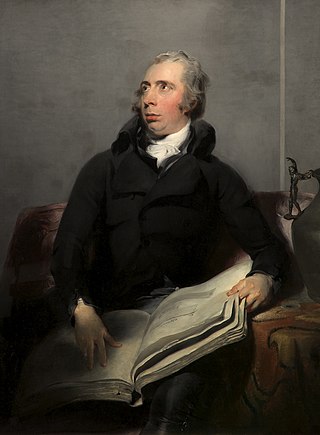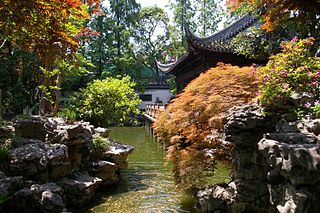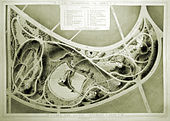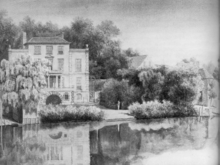
A landscape is the visible features of an area of land, its landforms, and how they integrate with natural or human-made features, often considered in terms of their aesthetic appeal. A landscape includes the physical elements of geophysically defined landforms such as mountains, hills, water bodies such as rivers, lakes, ponds and the sea, living elements of land cover including indigenous vegetation, human elements including different forms of land use, buildings, and structures, and transitory elements such as lighting and weather conditions. Combining both their physical origins and the cultural overlay of human presence, often created over millennia, landscapes reflect a living synthesis of people and place that is vital to local and national identity.

A shrubbery, shrub border or shrub garden is a part of a garden where shrubs, mostly flowering species, are thickly planted. The original shrubberies were mostly sections of large gardens, with one or more paths winding through it, a less-remembered aspect of the English landscape garden with very few original 18th-century examples surviving. As the fashion spread to smaller gardens, linear shrub borders covered up walls and fences, and were typically underplanted with smaller herbaceous flowering plants. By the late 20th century, shrubs, trees and smaller plants tend to be mixed together in the most visible parts of the garden, hopefully blending successfully. At the same time, shrubs, especially very large ones, have become part of the woodland garden, mixed in with trees, both native species and imported ornamental varieties.

RichardPayne Knight of Downton Castle in Herefordshire, and of 5 Soho Square, London, England, was a classical scholar, connoisseur, archaeologist and numismatist best known for his theories of picturesque beauty and for his interest in ancient phallic imagery. He served as a Member of Parliament for Leominster (1780–84) and for Ludlow (1784–1806).

The early history of gardening is largely entangled with the history of agriculture, with gardens that were mainly ornamental generally the preserve of the elite until quite recent times. Smaller gardens generally had being a kitchen garden as their first priority, as is still often the case.

The Japanese dry garden or Japanese rock garden, often called a Zen garden, is a distinctive style of Japanese garden. It creates a miniature stylized landscape through carefully composed arrangements of rocks, water features, moss, pruned trees and bushes, and uses gravel or sand that is raked to represent ripples in water. Zen gardens are commonly found at temples or monasteries. A Zen garden is usually relatively small, surrounded by a wall or buildings, and is usually meant to be seen while seated from a single viewpoint outside the garden, such as the porch of the hojo, the residence of the chief monk of the temple or monastery. Many, with gravel rather than grass, are only stepped into for maintenance. Classical Zen gardens were created at temples of Zen Buddhism in Kyoto during the Muromachi period. They were intended to imitate the essence of nature, not its actual appearance, and to serve as an aid for meditation.

Japanese gardens are traditional gardens whose designs are accompanied by Japanese aesthetics and philosophical ideas, avoid artificial ornamentation, and highlight the natural landscape. Plants and worn, aged materials are generally used by Japanese garden designers to suggest a natural landscape, and to express the fragility of existence as well as time's unstoppable advance. Ancient Japanese art inspired past garden designers. Water is an important feature of many gardens, as are rocks and often gravel. Despite there being many attractive Japanese flowering plants, herbaceous flowers generally play much less of a role in Japanese gardens than in the West, though seasonally flowering shrubs and trees are important, all the more dramatic because of the contrast with the usual predominant green. Evergreen plants are "the bones of the garden" in Japan. Though a natural-seeming appearance is the aim, Japanese gardeners often shape their plants, including trees, with great rigour.

Chinoiserie is the European interpretation and imitation of Chinese and other East Asian artistic traditions, especially in the decorative arts, garden design, architecture, literature, theatre, and music. The aesthetic of chinoiserie has been expressed in different ways depending on the region. It is related to the broader current of Orientalism, which studied Far East cultures from a historical, philological, anthropological, philosophical, and religious point of view. First appearing in the 17th century, this trend was popularized in the 18th century due to the rise in trade with China and the rest of East Asia.

Sir Uvedale Price, 1st Baronet, author of the Essay on the Picturesque, As Compared with the Sublime and The Beautiful (1794), was a Herefordshire landowner who was at the heart of the 'Picturesque debate' of the 1790s.

Ryōan-ji is a Zen temple located in northwest Kyoto, Japan. It belongs to the Myōshin-ji school of the Rinzai branch of Zen Buddhism. The Ryōan-ji garden is considered one of the finest surviving examples of kare-sansui, a refined type of Japanese Zen temple garden design generally featuring distinctive larger rock formations arranged amidst a sweep of smooth pebbles raked into linear patterns that facilitate meditation. The temple and its gardens are listed as one of the Historic Monuments of Ancient Kyoto, and as a UNESCO World Heritage Site.

William Sawrey Gilpin was an English artist and drawing master, and in later life a landscape designer.

William Gilpin was an English artist, Church of England cleric, schoolmaster and author. He is best known as a travel writer and as one of those who originated the idea of the picturesque.

The Chinese garden is a landscape garden style which has evolved over three thousand years. It includes both the vast gardens of the Chinese emperors and members of the imperial family, built for pleasure and to impress, and the more intimate gardens created by scholars, poets, former government officials, soldiers and merchants, made for reflection and escape from the outside world. They create an idealized miniature landscape, which is meant to express the harmony that should exist between man and nature.

The Daisen-in (大仙院) is a sub-temple of Daitoku-ji, a temple of the Rinzai school of Zen in Buddhism, one of the five most important Zen temples of Kyoto. The name means "The Academy of the Great Immortals." Daisen-in was founded by the Zen priest Kogaku Sōkō, and was built between 1509 and 1513. The Daisen-in is noted for its screen paintings and for its kare-sansui, or dry landscape garden.

The English landscape garden, also called English landscape park or simply the English garden, is a style of "landscape" garden which emerged in England in the early 18th century, and spread across Europe, replacing the more formal, symmetrical French formal garden which had emerged in the 17th century as the principal gardening style of Europe. The English garden presented an idealized view of nature. Created and pioneered by William Kent and others, the "informal" garden style originated as a revolt against the architectural garden and drew inspiration from landscape paintings by Salvator Rosa, Claude Lorrain, and Nicolas Poussin.

Topographical poetry or loco-descriptive poetry is a genre of poetry that describes, and often praises, a landscape or place. John Denham's 1642 poem "Cooper's Hill" established the genre, which peaked in popularity in 18th-century England. Examples of topographical verse date, however, to the late classical period, and can be found throughout the medieval era and during the Renaissance. Though the earliest examples come mostly from continental Europe, the topographical poetry in the tradition originating with Denham concerns itself with the classics, and many of the various types of topographical verse, such as river, ruin, or hilltop poems were established by the early 17th century. Alexander Pope's "Windsor Forest" (1713) and John Dyer's "Grongar Hill" (1726/7) are two other often mentioned examples. In following centuries, Matthew Arnold's "The Scholar Gipsy" (1853) praised the Oxfordshire countryside, and W. H. Auden's "In Praise of Limestone" (1948) used a limestone landscape as an allegory.
Yuanye, variously translated as The Garden Treatise or The Craft of Gardens, is a 1631 work on garden design by Ji Cheng of the late Ming dynasty. It is now considered the definitive work on garden design of the many produced during that period, and has been labeled as the first monograph dedicated to garden architecture in the world, and among the great masterpieces of garden literature.

The French landscape garden is a style of garden inspired by idealized romantic landscapes and the paintings of Hubert Robert, Claude Lorrain and Nicolas Poussin, European ideas about Chinese gardens, and the philosophy of Jean-Jacques Rousseau. The style originated in England as the English landscape garden in the early 18th century, and spread to France where, in the second half of the 18th century and early 19th century, it gradually replaced the rigidly clipped and geometrical French formal garden.
The Wye Tour was an excursion past and through a series of scenic buildings, natural phenomena, and factories located along the River Wye. It was a popular destination for British travellers from 1782 to around 1850, and reached its peak popularity during the Napoleonic Wars, when travel to Continental Europe was not an option.
Sakuteiki is the oldest published Japanese text on garden-making. It was most likely the work of Tachibana Toshitsuna.

Sharawadgi or sharawaggi is a style of landscape gardening or architecture in which rigid lines and symmetry are avoided to give the scene an organic, naturalistic appearance. This was supposedly a concept in the Chinese garden, and starting with Sir William Temple's essay Upon the gardens of Epicurus, may have been influential in English landscape gardening in the 18th century. The reports from China of the Jesuit missionary, Father Attiret added to this. Sir William Temple first used the word "sharawadgi" in discussing the Chinese idea of beauty without order in garden design, in contrast to the straight lines, regularity, and symmetries then popular in the formal Baroque gardens of Europe, led by the French formal garden. The style indicates a certain irregularity in the design.
























